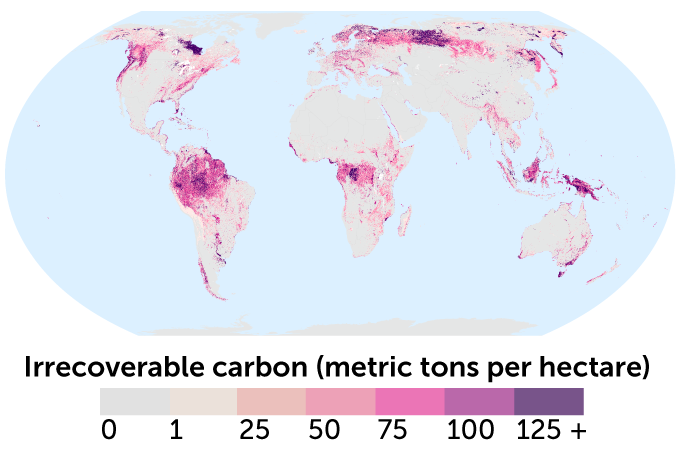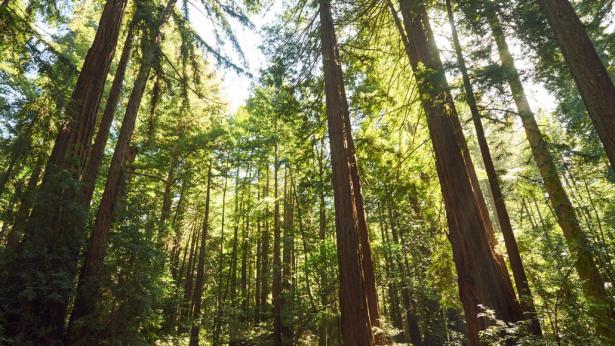Over decades, centuries and millennia, the steady skyward climb of redwoods, the tangled march of mangroves along tropical coasts and the slow submersion of carbon-rich soil in peatlands has locked away billions of tons of carbon.
If these natural vaults get busted open, through deforestation or dredging of swamplands, it would take centuries before those redwoods or mangroves could grow back to their former fullness and reclaim all that carbon. Such carbon is “irrecoverable” on the timescale — decades, not centuries — needed to avoid the worst impacts of climate change, and keeping it locked away is crucial.
Now, through a new mapping project, scientists have estimated how much irrecoverable carbon resides in peatlands, mangroves, forests and elsewhere around the globe — and which areas need protection.
The new estimate puts the total amount of irrecoverable carbon at 139 gigatons, researchers report November 18 in Nature Sustainability. That’s equivalent to about 15 years of human carbon dioxide emissions at current levels. And if all that carbon were released, it’s almost certainly enough to push the planet past 1.5 degrees Celsius of warming above preindustrial levels.
“This is the carbon we must protect to avert climate catastrophe,” says Monica Noon, an environmental data scientist at Conservation International in Arlington, Va. Current efforts to keep global warming below the ambitious target of 1.5 degrees C require that we reach net-zero emissions by 2050, and that carbon stored in nature stays put (SN:12/17/18). But agriculture and other development pressures threaten some of these carbon stores.
To map this at-risk carbon, Noon and her colleagues combined satellite data with estimates of how much total carbon is stored in ecosystems vulnerable to human incursion. The researchers excluded areas like permafrost, which stores lots of carbon but isn’t likely to be developed (although it’s thawing due to warming), as well as tree plantations, which have already been altered (SN: 9/25/19). The researchers then calculated how much carbon would get released from land conversions, such as clearing a forest for farmland.
That land might store varying amounts of carbon, depending on whether it becomes a palm oil plantation or a parking lot. To simplify, the researchers assumed cleared land was left alone, with saplings free to grow where giants once stood. That allowed the researchers to estimate how long it might take for the released carbon to be reintegrated into the land. Much of that carbon would remain in the air by 2050, the team reports, as many of these ecosystems take centuries to return to their former glory, rendering it irrecoverable on a timescale that matters for addressing climate change.
Carbon-rich lands
Researchers mapped the location and density of Earth’s irrecoverable carbon — carbon locked in ecosystems that is potentially vulnerable to release from human development and, if lost, could not be restored to those ecosystems by 2050. Areas of exceptionally high density of irrecoverable carbon (purple) include the Pacific Northwest, the Amazon, the Congo Basin and Borneo.
Irrecoverable carbon stores across the planet

M.L. Noon et al/Nature Sustainability 2021
Releasing that 139 gigatons of irrecoverable carbon could have irrevocable consequences. For comparison, the United Nations’ Intergovernmental Panel on Climate Change estimates that humans can emit only 109 more gigatons of carbon to have a two-thirds chance of keeping global warming below 1.5 degrees C. “These are the places we absolutely have to protect,” Noon says.
Approximately half of this irrecoverable carbon sits on just 3.3 percent of Earth’s total land area, equivalent to roughly the area of India and Mexico combined. Key areas are in the Amazon, the Pacific Northwest, and the tropical forests and mangroves of Borneo. “The fact that it’s so concentrated means we can protect it,” Noon says.
Roughly half of irrecoverable carbon already falls within existing protected areas or lands managed by Indigenous peoples. Adding an additional 8 million square kilometers of protected area, which is only about 5.4 percent of the planet’s land surface, would bring 75 percent of this carbon under some form of protection, Noon says.
“It’s really important to have spatially explicit maps of where these irrecoverable carbon stocks are,” says Kate Dooley, a geographer at the University of Melbourne in Australia who wasn’t involved in the study. “It’s a small percentage globally, but it’s still a lot of land.” Many of these dense stores are in places at high risk of development, she says.
“It’s so hard to stop this drive of deforestation,” she says, but these maps will help focus the efforts of governments, civil society groups and academics on the places that matter most for the climate.


Spread the word